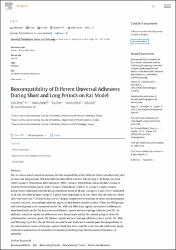| dc.contributor.author | Ünal, Murat | |
| dc.contributor.author | Göze Saygın, Ayşegül | |
| dc.contributor.author | Ünal, Murat | |
| dc.contributor.author | Koç, Tülay | |
| dc.contributor.author | Candan, Merve | |
| dc.contributor.author | İpek, İrem | |
| dc.date.accessioned | 2022-05-12T13:35:45Z | |
| dc.date.available | 2022-05-12T13:35:45Z | |
| dc.date.issued | 2021 | tr |
| dc.identifier.citation | Microscopy Research and TechniqueVolume 84, Issue 9, Pages 2140 - 2148September 2021
Document type
Article
Source type
Journal
ISSN
1059910X
DOI
10.1002/jemt.23769
View more
Evaluation of the microhardness of different resin-based dental restorative materials treated with gastric acid: Scanning electron microscopy–energy dispersive X-ray spectroscopy analysis
Ünal, MurataSend mail to Ünal M.;Candan, Mervea;İpek, İrema;Küçükoflaz, Merveb;Özer, Alic
Save all to author list
a Faculty of Dentistry, Department of Pediatric Dentistry, Sivas Cumhuriyet University, Sivas, Turkey
b Faculty of Engineering, Department of Biomedical Engineering, Erciyes University, Kayseri, Turkey
c Faculty of Engineering, Department of Metallurgy and Material Engineering, Sivas Cumhuriyet University, Sivas, Turkey | tr |
| dc.identifier.uri | https://www.scopus.com/record/display.uri?eid=2-s2.0-85123788773&origin=resultslist&sort=plf-f&featureToggles=FEATURE_NEW_DOC_DETAILS_EXPORT:1 | |
| dc.identifier.uri | https://hdl.handle.net/20.500.12418/12930 | |
| dc.description | - | tr |
| dc.description.abstract | This in vivo research aimed to compare the biocompatibility of five different Universal adhesives (UAs) in short and long periods. 108 polyethylene tubes filled with five UAs [Group 1: All Bond Universal (ABU), Group 2: Prime Bond Elect Universal (PBU), Group 3: Single Bond Universal (SBU), Group 4: Clearfil Universal Bond Quick (CUB), Group 5: Futurabond U (FBU)] or Group 6: empty (control group)] were implanted into the dorsal connective tissue of 36 rats. Groups 1, 2 and 3 were implanted in 18 rats, the other groups Groups 4, 5 and 6 were implanted in 18 rats. Then, the rats were sacrificed after time intervals 7, 30 and 90 days (n=12). Biopsy samples were examined in terms of inflammatory reaction, necrosis, macrophage infiltrate, giant cell and fibrous capsule criteria. When the UAs groups and control group were compared on the 7th, 30th and 90th days, significant statistical differences were found only on the 7th day in terms of fibrous capsule and macrophage infiltrate (p<0.05). In addition, statistical significant differences were found upon within the control group in terms of inflammation, necrosis, giant cell, fibrous capsule and macrophage infiltrate criteria on the 7th, 30th and 90th days (p<0.05). The all UAs that we used in our study have showed good biocompatibility in the subcutaneous tissues of the rats, and we think that they could be used clinically with resin-based restorative materials in all restorative treatments including deep dentine caries restorations. | tr |
| dc.description.sponsorship | - | tr |
| dc.language.iso | eng | tr |
| dc.publisher | Journal of Photopolymer Science and Technology, | tr |
| dc.relation.isversionof | 10.2494/PHOTOPOLYMER.34.321 | tr |
| dc.rights | info:eu-repo/semantics/closedAccess | tr |
| dc.subject | Biocompatibiltity; Rat; Short-Long Period; Subcutaneous Tissue; Universal Adhesives | tr |
| dc.title | Biocompatibility of Different Universal Adhesives During Short and Long Periods on Rat Model | tr |
| dc.type | article | tr |
| dc.relation.journal | Journal of Photopolymer Science and Technology, | tr |
| dc.contributor.department | Diş Hekimliği Fakültesi | tr |
| dc.contributor.authorID | 0000-0002-5909-0202 | tr |
| dc.identifier.volume | 3 | tr |
| dc.identifier.issue | 34 | tr |
| dc.identifier.endpage | 327 | tr |
| dc.identifier.startpage | 321 | tr |
| dc.relation.publicationcategory | Uluslararası Hakemli Dergide Makale - Kurum Öğretim Elemanı | tr |















